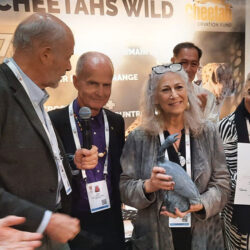New Study Links Neurological Disorders in Captive Felids to Improper Diet
-

- by CCF Staff December 30, 2014
FOR IMMEDIATE RELEASE
Contact:
Dr. Laurie Marker, [email protected] or (+264) (0)67 306225 or (+264) (0)81 1247887 or
Susan Yannetti, External Communications Manager; [email protected]
or 202.716.7756
New Study Links Neurological Disorders in Captive Felids to Improper Diet
OTJIWARONGO, Namibia (30 Dec, 2014) – Findings from a recently published research study confirm what many scientists have long suspected. A high incidence of neurological disorders among captive felids in the United Arab Emirates (UAE), including demyelination of the spinal cord, correlates to copper and Vitamin A deficiencies, which is attributable to meat diets not properly supplemented nor based on mixed, whole carcass prey. The study was conducted by the Central Veterinary Research Laboratory (CVRL) in Dubai, UAE, with collaboration from Cheetah Conservation Fund (CCF), Namibia; Institute of Animal Nutrition, Vetsuisse Faculty Zurich; and Centre for Applied Biotechnology and Molecular Medicine, University of Zurich.
The study compared blood and tissue samples among captive felids, including cheetahs, lions, and snow leopards, that were fed different diets. Thirty percent of the animals that did not receive supplements and existed primarily on a poultry muscle meat diet displayed clinical neurological signs such as ataxia, lack of coordination, swaying gait and moderate to severe hind limb weakness. Despite having normal appetites, these animals developed hind limb paresis and were eventually unable to stand. They either died or were euthanized, as damage is permanent and there is no treatment.
“The Role of Copper and Vitamin A Deficiencies Leading to Neurological Signs in Captive Cheetahs (Acinonyx jubatus) and Lions (Panthera leo) in the United Arab Emirates”, was published in Food and Nutrition Sciences (2014, 5, 1978-1990). Claudia Kaiser, DVM, of the CVRL and the Institute of Animal Nutrition, Vetsuisse Faculty Zurich, Zürich, Switzerland, is the study’s lead author. Dr. Kaiser worked with the CVRL from 2012 to 2013 and completed the study as her Doctoral thesis from Zurich University under the supervision of Prof. Annette Liesegang.
“We did this study because of all the post mortem findings of the previous years at the CVRL. Due to the fact that there was demyelinisation of the CNS in a lot of felids that were ataxic before euthanasia or natural death, we wanted to know if there was a correlation between the symptom and their nutrition. The results showed us that a supplemented diet is one of the key factors of keeping wild animals healthy in captivity”, said Dr. Kaiser. “Captive animals cannot care for themselves, so it is our responsibility to optimise their lives in captivity”.
According to Dr. Laurie Marker, Founder and Executive Director of CCF and one of the study’s co-authors,cheetah myelopathy is the term used to describe ataxia, hind limb paralysis and pareses caused by degenerative lesions on the spinal cord. It’s been found historically among some cheetahs kept in zoos, wildlife parks and private collections, but is now being reported with alarming frequency in the United Arab Emirates, where cheetahs are popularly kept as exotic pets, most often where the cheetahs were illegally catured in the wild. Cheetah myelopathy can lead to vision loss, muscle weakness, stiffness, spasms, loss of coordination, loss of sensation, pain, and changes in bladder and bowel function. The majority of these cases are fatal.
“Many Emirates view cheetahs and other large felids as status symbols, but are often unfamiliar with the animal’s proper care or diet. Big cats need the vitamins, minerals and trace elements found in bones, viscera, fur and feathers to remain healthy”, said Dr. Marker. “Unfortunately, many cheetahs kept as pets are not fed whole carcasses with appropriate supplements, nor are they provided with the correct supplements to balance their diet. As a result, they experience debilitating health problems, and many will die prematurely”.
With fewer than 10,000 wild cheetahs remaining and 50 to 70 percent of poached cubs dying en route to the Arabian Peninsula, there is little doubt the illegal trade in cheetahs is taking an already endangered species closer to the brink of extinction. “More education is needed to reduce the demand for cheetahs as exotic pets. If these wealthy exotic animal owners truly care about their animals, they would use their resources to educate others and help protect these majestic creatures where they belong, in the wild”, added Dr. Marker.
Cheetah Conservation Fund
The Cheetah Conservation Fund (CCF) is the global leader in research and conservation of cheetahs. CCF is a Namibian non-profit trust dedicated to saving the cheetah in the wild. CCF believes that understanding the cheetah’s biology, ecology and interactions with people is essential to conserve the cheetah in the wild. The strategy is a three-pronged process of research, conservation and education, beginning with long-term studies to understand and monitor the factors affecting the cheetah’s survival. Results are used to develop conservation policies and programs. CCF works with local, national and international communities to raise awareness, communicate and educate.
The Central Veterinary Research Laboratory (CVRL) was founded 1985 by HH Sheikh Mohammed Bin Rashid Al Maktoum, Vice President and Prime Minister of the UAE and Ruler of Dubai. Fifteen departments form the veterinary centre of excellence, known all over the world for its grass roots work in diagnostic and research of animal diseases. During the course of almost three decades, the CVRL scientist published 520 + peer reviewed papers and six books. Under the Scientific Director, Dr. Habil Ulrich Wernery, and the Administrative Director Dr. Ali Ridha, the CVRL was recognized as an OIE Reference Laboratory for Camelpox and Glanders and is accredited by the European Union as the only testing unit for notifiable diseases in equids in the Middle East.
Related Reading


